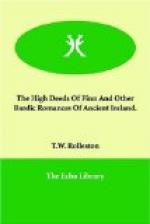mingle an impression of youth with one of age.
This is very pleasant to the imagination, and especially
so if the myths, as in Ireland, have some poetic beauty
or strangeness, as in the myth I have referred to—of
the deep spring of clear water and the nine hazels
of wisdom that encompass it. This mingling of
the beauty of youth and the honour of ancientry runs
through all the Irish tales. Youth and the love
of it, of its beauty and strength, adorn and vitalize
their grey antiquity. But where, in their narrative,
the hero’s youth is over and the sword weak
in his hand, and the passion less in his and his sweetheart’s
blood, life is represented as scarcely worth the living.
The famed men and women die young—the sons
of Turenn, Cuchulain, Conall, Dermot, Emer, Deirdre,
Naisi, Oscar. Oisin has three hundred years of
youth in that far land in the invention of which the
Irish embodied their admiration of love and youth.
His old age, when sudden feebleness overwhelms him,
is made by the bardic clan as miserable, as desolate
as his youth was joyous. Again, Finn lives to
be an old man, but the immortal was in him, and either
he has been born again in several re-incarnations (for
the Irish held from time to time the doctrine of the
transmigration of souls), or he sleeps, like Barbarossa,
in a secret cavern, with all his men around him, and
beside him the mighty horn of the Fianna, which, when
the day of fate and freedom comes, will awaken with
three loud blasts the heroes and send them forth to
victory. Old as she is, Ireland does not grow
old, for she has never reached her maturity. Her
full existence is before her, not behind her.
And when she reaches it her ancientry and all its
tales will be dearer to her than they have been in
the past. They will be an inspiring national asset.
In them and in their strange admixture of different
and successive periods of customs, thoughts and emotions
(caused by the continuous editing and re-editing of
them, first in oral recitation and then at the hands
of scribes), Ireland will see the record of her history,
not the history of external facts, but of her soul
as it grew into consciousness of personality; as it
established in itself love of law, of moral right,
of religion, of chivalry, of courtesy in war and daily
life; as it rejoiced, and above all, as it suffered
and was constant, in suffering and oppression, to
its national ideals.
It seems as if, once at least, this aspect of the tales of Ireland was seen by men of old, for there is a story which tells that heaven itself desired their remembrance, and that we should be diverted and inspired by them. In itself it is a record of the gentleness of Irish Christianity to Irish heathendom, and of its love of the heroic past. For one day when Patrick and his clerks were singing the Mass at the Rath of the Red Ridge, where Finn was wont to be, he saw Keelta, a chief of the Fianna, draw near with his companions, and Keelta’s huge hounds were with him. They were men so tall and great




